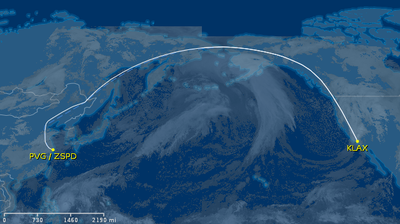
| home:travel:china | site map | help |
| Trip to China: Shanghai and Huangshan (Yellow Mountain) |
Date: December 23rd to December 30th, 2016
As 2016 was drawing to a close, I once again found myself about 10,000 miles short of maintaining a Premier status with United. Thus it was time for yet another mileage run - just like last year's trip to Chile. Although honestly, that was just an excuse. We both love traveling, and this year our only together trip outside of USA was a weekend in Vancouver before the RGD conference. Sandra also just recently got her blue US passport so it was time to get some stamps in it! The earlier plan called for visiting Slovakia, but ticket prices to Europe over Christmas were astronomical. I thus fired up the Great Circle Mapper and started looking for airports outside the diameter of my missing miles. One city Sandra always wanted to take me to was Shanghai. She spent three months there back in 2008 studying Mandarin. To this day Shanghai remains one of her favorite places. United offers a direct flight from LAX and the price was quite affordable. So Shanghai is where we decided to go. During her previous stay, Sandra also visited Huangshan (The Yellow Mountain), a UNESCO World Heritage site not too far away. This trip in a way ended up being a redo of 2008, except now with me in tow. And also in winter.
Visiting China requires an entry visa. Lucky for us, there is a consulate in LA, so I just drove down with the passports. The application offers options for single or multiple entries up to 1 year, with all costing the same. I ticked the latter, and was pleasantly surprised to find out we received multiple entry visas not for 1, but for 10 years. This is great as there is much of China left to explore. One day I would love to return to the western Yunnan and Sichuan provinces to see the mountains. To keep the cost down, we ended up using our Hyatt points and free night bonuses from the Chase Hyatt credit card. Hyatt has multiple properties in Shanghai, including an Andaz in the Xintiandi district where we ended up staying for the first 3 nights. There is also a Park Hyatt. This hotel's claim to fame is being at one point the highest hotel in the world (it's now the second). I had just enough points for one night as it couldn't be booked with the free annual credit, which is good only for Category 1-4 properties. In between, we stayed two nights on the mountain. This is the part that was confusing to me. I couldn't comprehend there being actual hotels on top of a mountain. Yet there are. We need to give some serious credit to the Chinese for their construction abilities. The Yellow Mountain has no roads going to the top, and as you will see below, is serviced by cable cars and porters who carry supplies on their backs. Yet somehow the Chinese managed to build not one, but around a half a dozen of luxury four-star hotels at the summit. We stayed in XiHai. It had one of the best reviews. Note this link goes to a travel agency. We ended up booking the hotel through CTrip, as the company at the link was asking for copies of passports to be sent through unsecured email. Finally, we used TravelChinaGuide.com to book the train tickets. They were waiting for us at the Andaz when we arrived.

The flight to Shanghai was uneventful. It was totally quiet - I don't think there was a single baby on board. And best of all: no banging noise like on the way to Hong Kong! The downside was the flight was very long - almost 15 hours. This was because, for some unknown reason, we stayed over land for almost the entire way! It did not even occur to me that you could actually drive from Los Angeles to Shanghai, but the pilot demonstrated it is almost feasible. The weather was bad in LA, with rain and strong wind delaying our departure as we waited for winds to ease to allow our fat plane to take off. Perhaps that would explain the initial route over Northern California. Yet we continued flying over Oregon, Washington, Canada, Alaska, and eventually crossed to Russia over the Bering Strait. This 51 mile gap was one of only two times we flew over water. We then continued over Russia into China. We could have remained over land for the remainder of the journey but instead the plane took a brief shortcut over the Bohai Bay. Just for comparison, the flight back followed a route closer to the great circle, and took only 11 hours. I ended up watching The Lobster, a futuristic movie about a world in which single people have only 45 days to find a mate before they are turned into an animal. I very much enjoyed it but apparently it's an acquired taste kind of a movie.
We arrived in Shanghai around 7pm on Christmas Eve. Being the most populous city in the world's most populous country, I expected the airport to be bursting at the seams. Instead, the cavernous airport was fully deserted. The same story was true for the metro. It was only as full as a typical US subway on a weekend. Most seats were occupied but I was one of the few people standing. It took us around an hour from landing to arriving at the hotel. The Xintiandi Andaz is really nice. It is now one of my favorite hotels. It is located in a 28 story high rise and features a contemporary layout. The hallways are decked out in wood, and the spacious rooms come with full size windows and a bathroom with rock siding. The bathroom even had different colored mood lights. Upon arriving, we encountered our version of a first-world problem as it took us about 20 minutes to figure out how to turn on the lights and open the blinds. Somehow we missed the buttons in a pullout drawer by the bed, and failed to notice a strange tablet near the TV. This tablet is the central control, and you use it to not only turn on the lights and open the blinds, but to possibly also order room service and what not. Pretty neat. The hotel offers free wifi, which allowed access to Facebook, Twitter, and Google. These site are blocked in the rest of China.
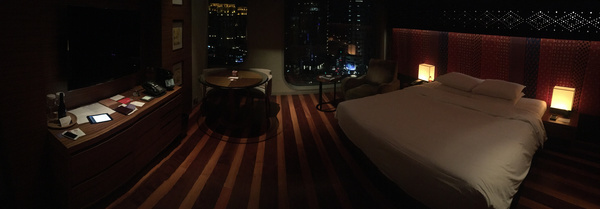
We next went on a hunt for food. I was expecting something akin to Japan, with dozens of tiny eateries on each block, but that was not the case. Instead we walked for an hour without finding a place to eat. Turns out, Xintiandi is this uber trendy area of Shanghai, and instead of small eateries, you have shopping malls filled with Cartier, Bulgari, and other exotic brands that us poor Americans simply can't afford to shop in. The heart of Xintiandi is a large pedestrian zone with restaurants, but these were all western style gastropubs and pizza parlors, with lines of well dressed Chinese millennials waiting for a table. I wasn't too keen to be making a line for a burger and thus we continued walking the blocks. We finally gave up and decided to try a Hoegarten brew pub right next to the hotel. Well as luck would have it, we noticed a small Chinese restaurant down a side street from the hotel. We had a delicious meal here. I ordered a roasted eggplant and Sandra got fried noodles. We were also served some lukewarm brown water which I was bit skeptical to drink. I think it was barley tea, drink quite popular here but also one I was totally unfamiliar with. Despite continuing to consume various strange drinks and foods, my stomach remained totally fine the entire trip. The respiratory tract was a different story as both of us managed to catch a nasty cold towards the end of the trip.
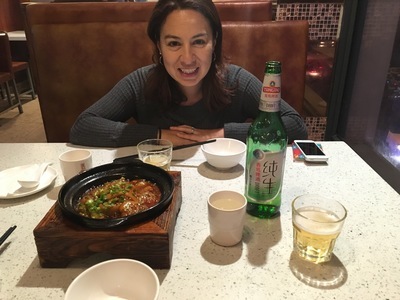
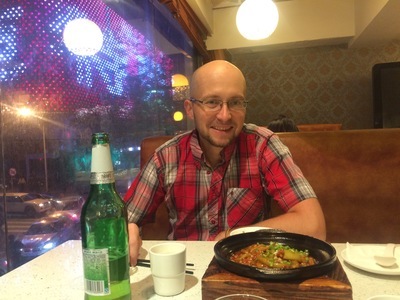
The next day was spent exploring Shanghai. The city is very easy to get around using the metro. Tickets cost around 50 cents, depending on the distance, and are easily purchased at the automated machines. You use these by first selecting the line of the destination station, and then clicking the name of the station where you plan to get off. This is all in English. You then put in the coins or the bills and out come the tickets. One slightly annoying aspect is that there is a security at all entrances and you need to pass all backpacks or suitcases through an X-ray scanner. We started sightseeing by getting off at People's Square and checking out the nearby park. It was drizzling and we noticed many open umbrellas left along one of the walkways. We weren't sure of the symbolism but I guess it was some commemoration. We also saw many people playing badminton in the open. This was great. I love badminton and only wish it was more popular in the USA. We then walked down the famed Nanjing Road towards the Bund, from where you get a nice view of the Pudong skyline across the Huangpu river. Sandra took a photo here back in 2008. We tried taking a similar picture but forgot to put a copy on our phone for reference. It was very windy along the river so we didn't linger too long. From the Bund we walked down to the Yu Garden. This is a large Chinese garden dating back to 1559. The garden is located near a temple and within a large bazaar. The area outside was quite crowded with people going about with their umbrellas on this rainy day, but inside the garden was very peaceful. At least I felt at peace until realizing the place was a maze with no obvious way out and slight claustrophobia started getting a hold of me.
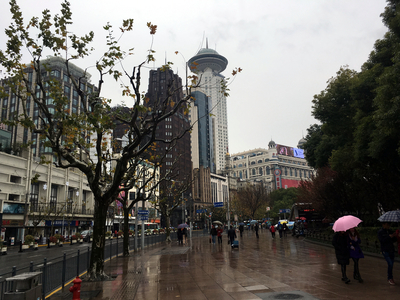
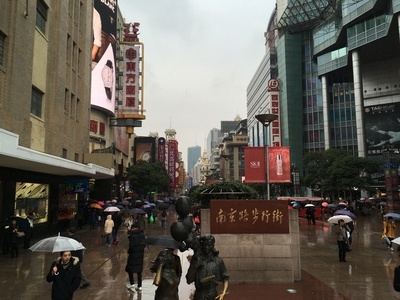
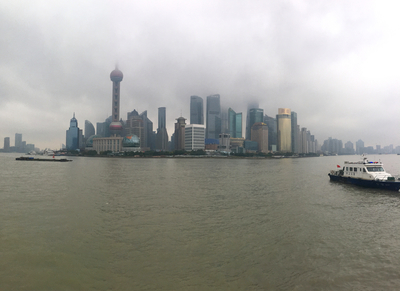
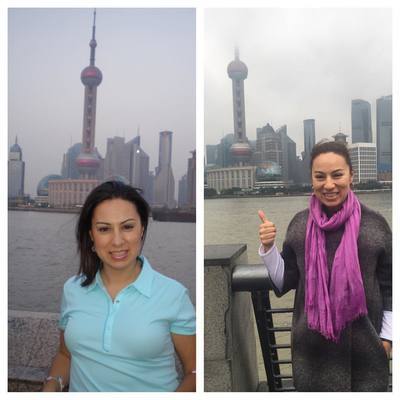
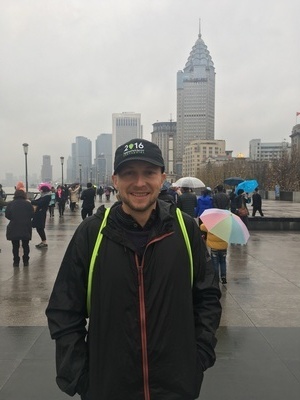
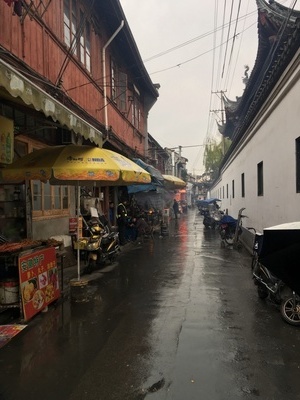
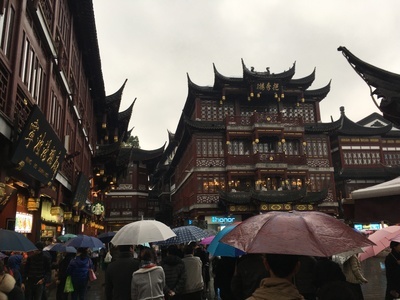
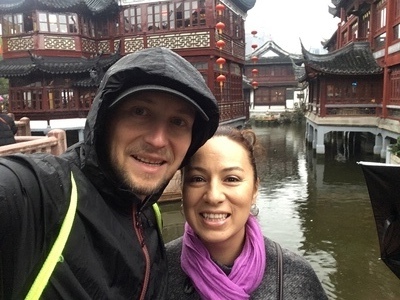
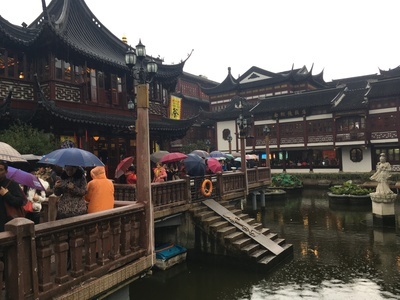
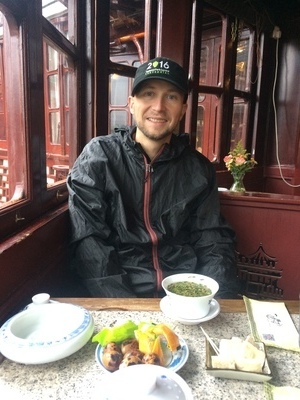
By now it was starting to get dark and we were soaked from the incessant rain, so we decided to head back to the hotel. We got off at the south end of Xintiandi (at the metro stop of that name) and walked through the many shopping malls. We ended up making a reservation at this fancy deserts and wine place, which although fine in all aspects, felt bit as a rip off. We also had dinner at a restaurant recommended by the staff at this deserts place which again was a letdown. I ordered an eggplant dish similar to the one from the night before. It ended up being more expensive and less flavorful. The next morning we started with lap swimming in the hotel pool. We then ventured to the western part of the city. We first visited the Jing'an Temple. I enjoyed the coalescence of the old and new, with a massive skyscraper overlooking the temple grounds. We then went searching for the hotel where Sandra stayed. We found it, although it now had a new name and nicer facade. As the weather continued to be cold and drizzly, we called it a day and continued sightseeing inside: by visiting the many shopping malls. The shopping malls in Shanghai are a sight to see. Here in LA we have a famous street filled with various luxury brands called Rodeo Drive. I felt like every block in Shanghai had a mall that had all the stores of Rodeo Drive, but multiplied by two. The malls are also ridiculously big, spanning 10 or even more floors. In Xintiandi we randomly stumbled into the K11 "art mall". This mall didn't have many shops, but is definitely worth a visit. It attempts to combine art with retail, and for instance, one restaurant had a full vegetable garden growing outside the entrance. We had a juice drink and a cake in a cafe here. The juice was served in a ridiculously tall glass and was delicious. The cake was a durian layer cake. I wanted to try this fruit which is not common in the US. The cake tasted good, but I continued burping the durian for the next few hours. That was less pleasant. We returned to the mall later that evening for dinner in a pizza parlor.
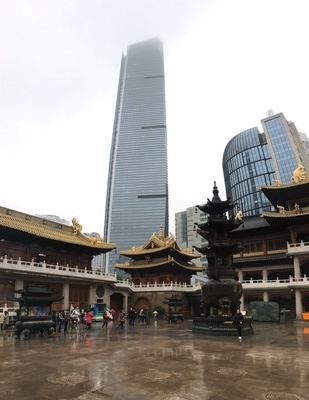
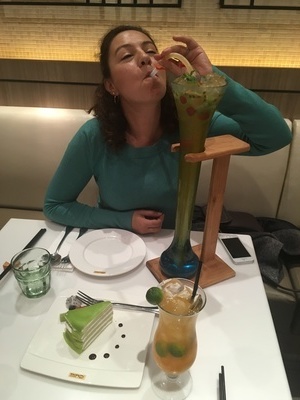
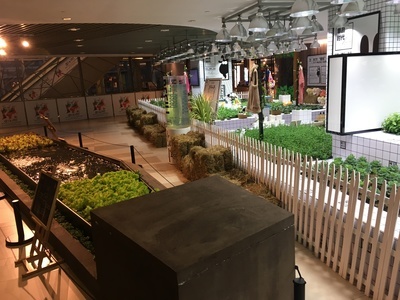
The next morning we checked out early and headed cross town to the Hongqiao train station. This station is located near the domestic airport and is the departure point for the bullet trains. We were taking one of them to the town of Tunxi, now renamed to Huangshan. This journey took around 4 hours, which was a breeze compared to the 12 hours on the regular overnight carriage. We had seats booked in "first class", which is actually the middle class, below "business" but above 2nd class. The company booking our tickets got us seats in the first row, which as we found out once boarded, don't come with windows. In your travels, make sure not to sit in the first row!. At least on the way to the mountain we shared a small part of a window with the second row, but on the way back the seats were reversed and there was only a solid wall to look at. Part of the magic of taking a train is being able to watch the country side so this was a let down. Luckily, the family sitting behind us noticed our predicament and volunteered to switch with us.
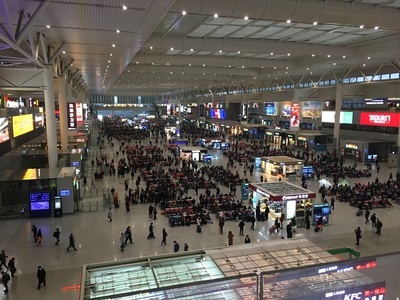
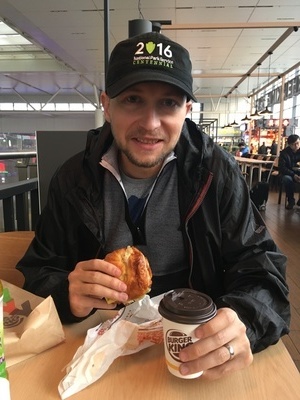
The Huangshan train station is located about an hour by car from Huangshan proper. In order to reach it, you can take a bus or a taxi. On the train, we struck a conversation with an Indonesian family, wife from which was fluent in Mandarin. They were taking the taxi so we decided to follow their lead. The taxi is more expensive, yet quite affordable at around 20 dollars. Besides simpler, we also figured this way will be faster as we were pressed for time. The train arrived at 1:15 pm, and the last cable car up the mountain was at 4pm. The taxi drops you off just outside the park as only park buses are allowed to operate inside. We first had an overpriced lunch before continuing the journey. Ordering food in China is relatively simple as all menus come with pictures. On the other hand, the waiters typically don't give you much time to study it and here we hurriedly ordered two dishes recommended to us. I guess these were the local specialties. Mine was some really strange stinky tofu curry, while Sandra ended up with a beef hot pot. The tofu dish was very flavorful, but in a way of a dirty sock stew. I ended up finishing all of it, but I don't think I would be ordering this meal again.
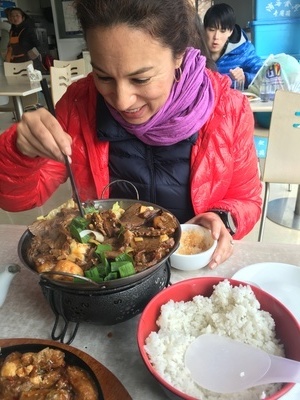
After lunch, we hopped on the bus which took us up a windy mountain road to the Yungu cable car station. This is one of three cable cars that can be used to reach the top. The one closest to the hotel is the Taiping line, but that one starts on the opposite, northern side, of the mountain. Being late in the day, we were one of only few people heading up. I am used to taking cable cars from Slovakia, but this ride was quite unnerving, to be frank. You end up going up between steep cliffs hundreds of feet above the canyon floor. On top of this, the green scenery gradually started turning silver and finally fully white. There were massive icicles hanging off the cable towers, which made me wonder if the car may somehow derail. Howling gusts of wind made the cable car sway left and right. After some 12 minutes which seemed like eternity we finally reached the winter wonderland on top.
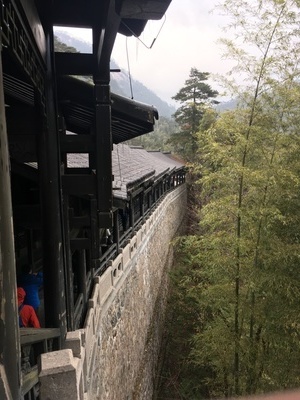
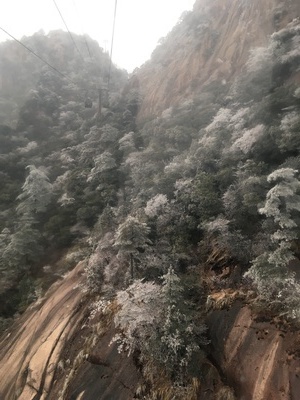
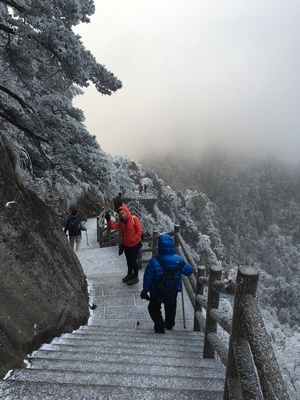
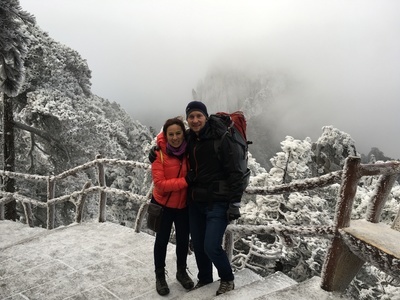
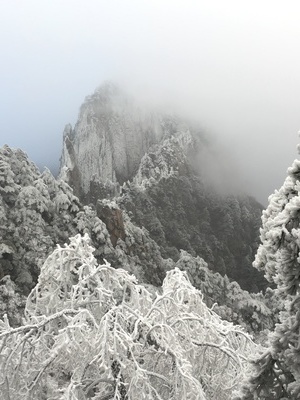
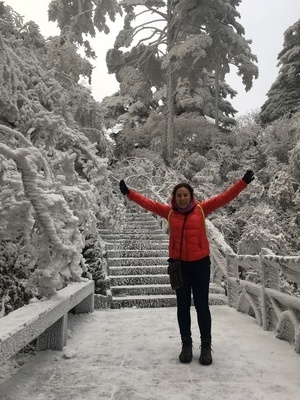
From the cable car it was over a mile to reach to hotel. Hence, make sure to pack light. We only carried one backpack, which made reaching the hotel much simpler (the other suitcase was left at a storage at the Shanghai train station for around $7 per day). Finding good maps of the Huangshan area is tricky but luckily there are many signs along the way. The XiHai hotel is quite impressive. The lobby contains the reception, bar, and a restaurant. The basement floor has some banquet rooms as well as another restaurant where buffet style dinner is served. Above the lobby are three floors of rooms. We were given a room with a balcony overlooking a massive canyon. The balcony chairs were fully covered with ice so we ventured outside only to snap brief pictures. It was around -10C at this point. During the check in, we were asked to pay 500 yuan in cash as a deposit, so make sure to carry some extra cash with you. But just in case, there is an ATM located about 10 minutes away by the BeiHai hotel. The downside of the hotel was the heating system. It was brutally cold in the room and not much warmer in the rest of the hotel. We had the heat cranked up all the way, and still the first night, the temperature did not exceed 14C (57F). It was pretty much impossible to do anything in the room besides immediately slipping under the massive duvets. We had dinner in the a la carte restaurant, where we also had free breakfast the next morning. The food was quite good and reasonably priced. What impressed me the most was the massive wine collection. On a closer inspection, it appeared that almost all bottles were 1982 Chateau Lafite Rothschild Pauillac. Based on a quick estimate, there was over a million dollars worth of wine here. I asked my friend Patricia, a professional wine purchaser, about this:
Why the heck did they have so much '82 lafitte!?! Nothing like a little variety, haha. The famous first growth Bordeaux houses like Lafitte are HUGE in moneyed china. Very big status symbols there along with the big napa Cab houses to a lesser extent. Rumor has it the rich Chinese will mix with soda because they buy it for the status, not because they like it! Each bottle would easily get $2500, and as much as $4000 through some sites, on the auction market. Lafite makes a lot of wine, usually over 15k cases a vintage so it wouldn't be absurd to think a nice hotel in china where the wine is so iconic would have their own set of 400ish bottles (though why it's the only wine they seem to have, and only one vintage at that, is beyond me). I'd be curious to see how they got it. With old wine it's important to trust the source and since the wine is so sought after in china, it could be pretty easy to take advantage of buyers and pass along counterfeit wines. It also kills me a little (lot) inside to see the sunlight hitting those bottles and how most are upright instead of on their sides. they're just asking to ruin the wine. Underlines how much of a status symbol it is vs. people really caring about the product they're getting.
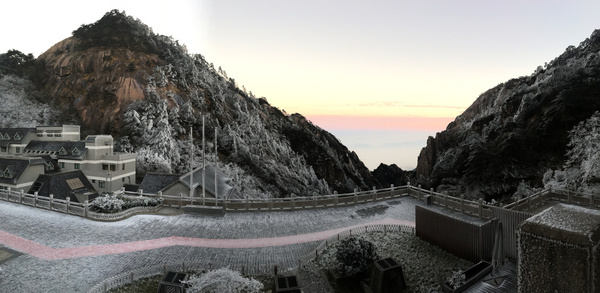
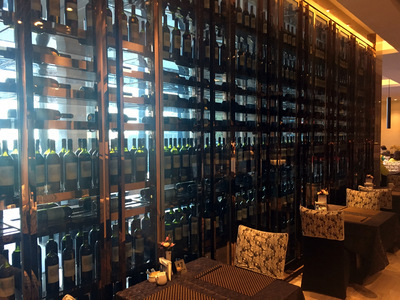
We spent the next day exploring the mountain area. Despite temperatures staying below freezing, much of the snow evaporated overnight. The trails were still icy, so we made heavy use of the micro-spikes purchased at the bottom for a very affordable three dollars each. We first headed towards the Taiping cableway, where we climbed to the top of the nearby Purple Cloud peak. This cableway differs from the two on the southern side in that it uses much larger capacity cabins. The ones on the south side are the smaller cars with room for four. We next walked south towards the XiHai grand canyon. This area is absolutely spectacular and stomach turning with overlooks of massive cliffs. Normally, you would walk past 1st and 2nd "rings" to a monorail that takes you across the canyon floor to the other side. Unfortunately, the route was closed before the 1st ring due to winter conditions. The monorail was also not operating. We thus continued on foot towards the Bright Top meteorological station. Here near the Baiyun hotel was the only time we encountered massive crowds. It seemed to me that many day tourists ride the Yuping cable way up and hike to this pavilion where they have lunch before heading back down again. That evening we sat down in the bar next to two guys. Turns out they were not just from California, but from the same part of Los Angeles as us. Talk about a small world!

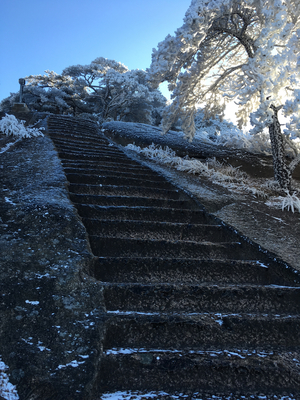
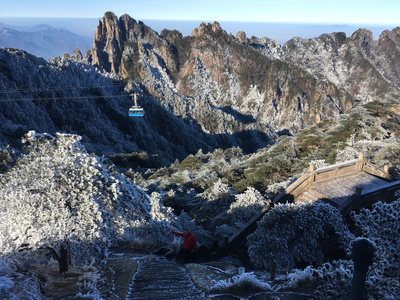
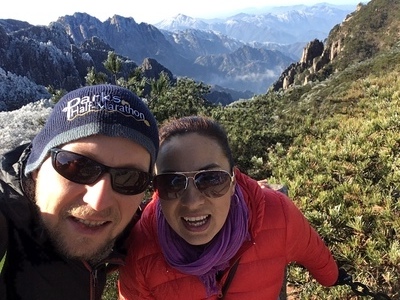
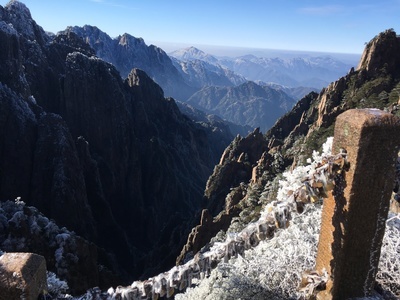
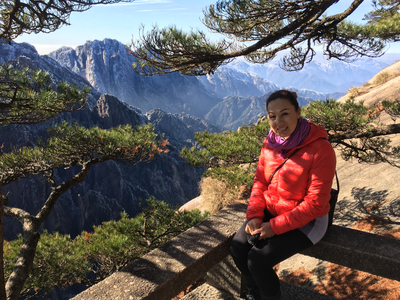
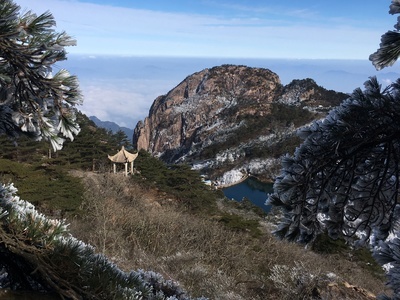
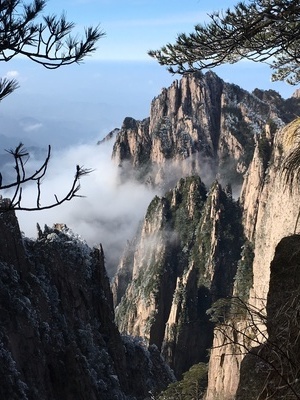
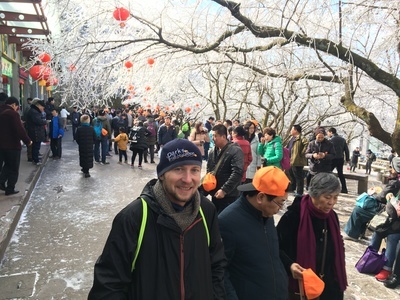
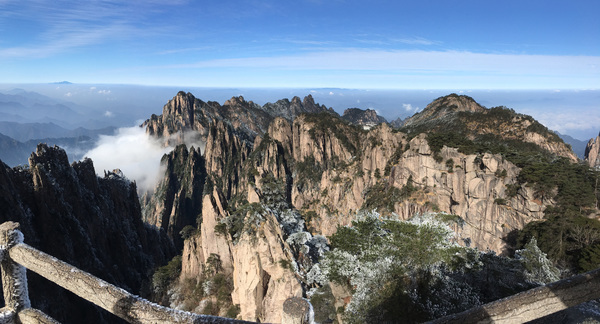
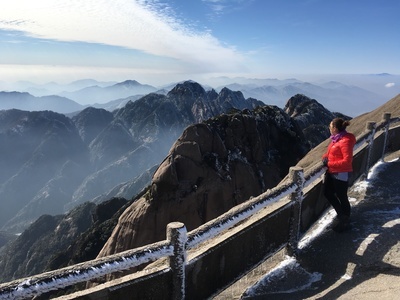
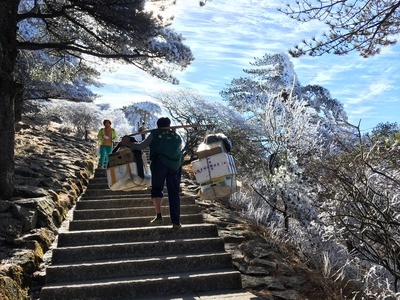
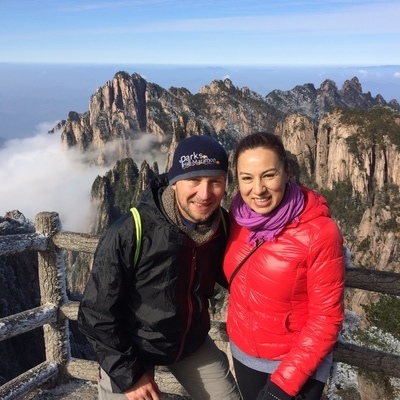
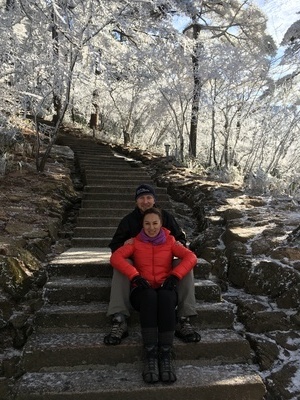
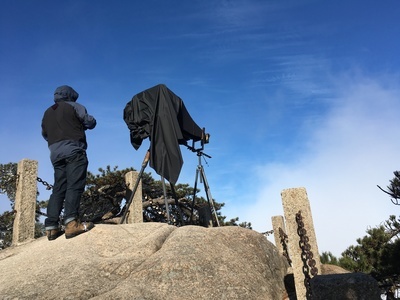
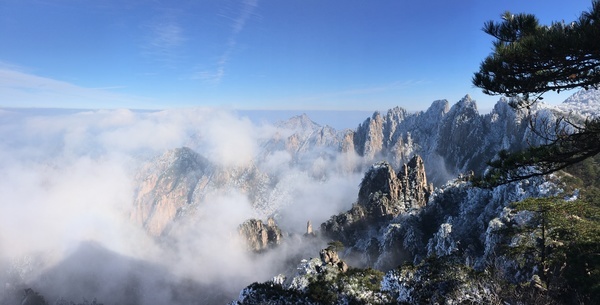
The next morning, after another night in a now slightly warmer 18C (64F) room, we set off to hike out. We decided to go down the Yuping cable car. This way took us on a really steep staircase towards the famous Guest Greeting Pine. On the ride down we saw what looked like part of the hiking route. I am not sure if this is the official route or just some old detour, but it consisted of wooden planks sticking out from the side of a deep cliff. No thanks! Once again we took a cab to the train station. We got there with about 2 hours to spare. I wasn't sure how long the trip will take, so we left at 8am to make our 2pm train back. We spent the two hours by grabbing lunch in Mr. Lee noodle restaurant, and then visited various shops to pick up tea. The Huangshan area is a famous tea producing region and many tea plantations can be seen on the way to the mountain.
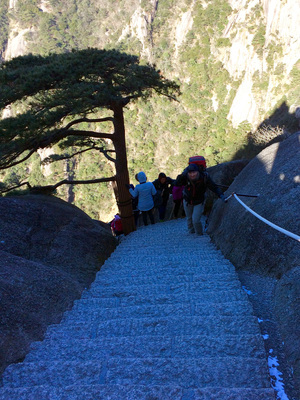
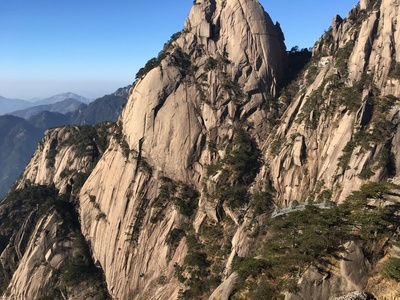
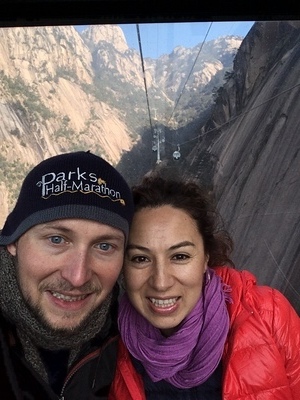
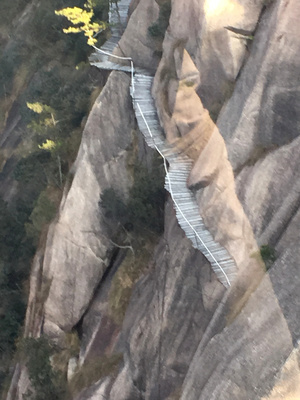
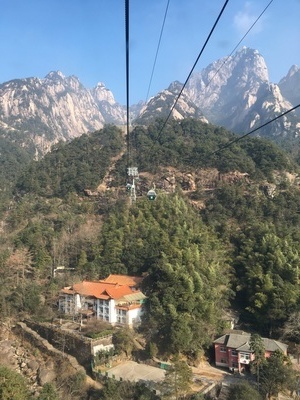
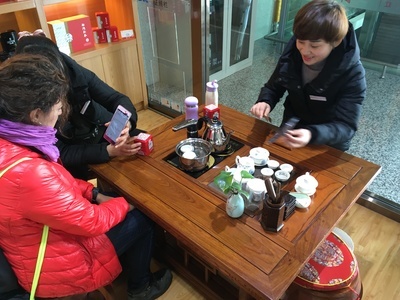
We arrived back in Shanghai around 6pm, just in time for the evening rush. The metro was more crowded now. By luck, the family that switched their seats with us on the train ended up in the same metro car. We were told it's rare to see snow on Huangshan, so this was a very special trip. This was the father's 3rd time up the mountain, but first time in winter. We got off in Pudong, the part of Shanghai across the Bund and famous for its many skyscrapers (but it's not as if the rest of Shanghai was lacking in tall buildings). We were staying in the Park Hyatt. Similar to the one in Tokyo, reaching the reception requires navigating through a maze of closed doors. A fast elevator takes you to the 87th floor in just few seconds. The rooms are actually below the reception, and we were given one on the 80th floor. The view from the room was spectacular. We could not see the famous Pearl Tower, but instead were looking at the newly built Shanghai Tower. This is now the second tallest building in the world. Despite us already so high above the rest of Shanghai, our next door neighbor was completely towering over us. That night we had dinner in the restaurant on the 91st floor followed by a drink in the "Music Room" bar one floor higher.
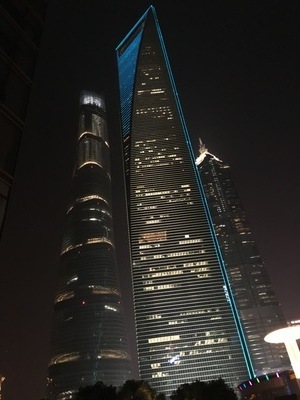
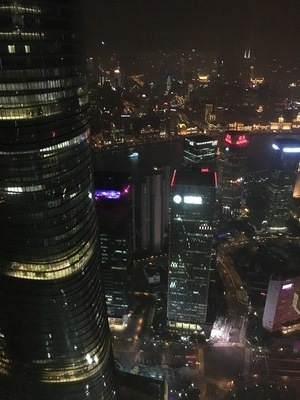
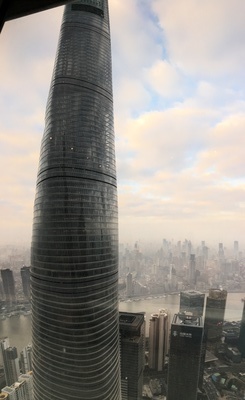
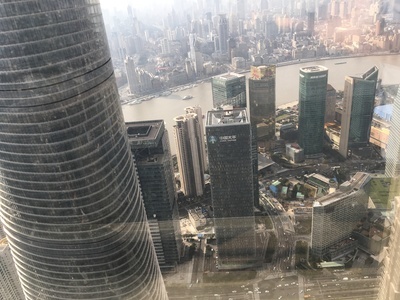
The next day we had until around 5pm to explore the rest of Pudong. We started the day with a swim in the pool that unfortunately did not make our cold any better. We were feeling quite crappy today, partly because the cold medicine ran out. For breakfast we walked to a pastry shop near Hotel Kempinski and from there headed back by the Pearl Tower to the "Super Brand Mall". Despite the name, this was the least upscale of all the malls we visited. Sandra wanted to do some shopping, but did not find anything not available in the US for the same price. Despite China having the reputation around the world for cheap clothing, we did not find this to be true, at least not in Shanghai. The stores carried the same brands one would find in the US and priced for roughly the same amount. Today was a clear, but cold day. We originally wanted to visit the Century Park, a large park in Pudong similar to the Central Park in New York. But we continued feeling crappy and stayed indoors. We next visited the pricier IFC mall. We window shopped a bit before returning to the hotel to check out. After leaving bags at the reception, we headed next door the Grand Hyatt for tea.
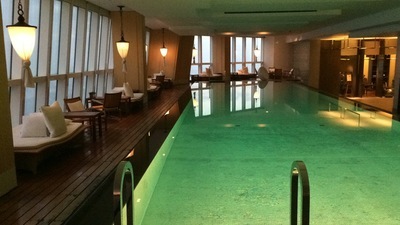

At 5pm we took a cab to the airport. The cab ride was more expensive and took longer than the metro, but was less hassle. The downside was that I was really started to get affected by the smog. The air quality seemed good the first three days, probably because the rain brought down any particulates. However, today, my eyes and throat were scratchy and I honestly could not wait to get out of the cab. We got to the airport about 2 hours prior to our departure, which was just in time. The line to check in with United was perhaps an hour long. Luckily the premier access line was much shorter, so we marched towards the front. During the check in, we were told that the economy plus was overbooked and were given one complimentary upgrade to the business class. Sandra didn't mind me taking it, so I enjoyed the trip back in a lay flat seat. This is the proper way to travel! After dinner, I went to sleep and didn't wake up until 8 hours later, just in time for breakfast. On this route I ended up watching The Hunt for the Wilderpeople, which was another enjoyable movie. The seat next to me, as well as another one across the aisle, remained empty so in theory United could have upgraded more people. Just prior to landing, the pilot mentioned over the intercom that after we touch down, some company representatives will come on board to speak to some passengers and that everyone else should remain seated. I only found out later from Sandra that supposedly there was some stuck-up Chinese lady in economy plus who kept demanding that she gets upgraded just as her husband. Supposedly she repeatedly kept going to the business class and kept demanding the same food and even the slippers, before engaging in a phone call (over WiFi?) during the flight. They were the family that got escorted off the plane.
To summarize, this was an amazing trip. If you get a chance to visit Shanghai: go! The downside is that the construction and infrastructure there will make you feel like you are living in a third world country in the USA. I found China very easy to get around, despite our lack of language skills. Keep in mind that many western websites, including anything Google are totally blocked in China. This means that you won't be able to use Gmail to communicate with friends, and also won't be able to use Google Translate or Google Maps in a connected mode. Luckily, the first allows you to download the Chinese dictionary and the latter caches recently visited area (downloading the "local area map" is also disallowed for China). So before leaving, make sure to download the dictionary and then move around and zoom in Google Maps to get the areas where you plan to travel. The Hyatt hotels had access to these websites. I am not sure if this is some exception granted to these hotels, as Google and Facebook remained blocked at the Star Alliance lounge in the Pudong airport. What surprised me was that besides Google, DuckDuckGo, my default search engine, was also blocked. Yahoo and Bing continued to work normally however. Most malls and restaurants offer free WiFi. But in order to use it, you need to enter your phone number to receive the access code. We did not try using this with an international phone number but I doubt it would work. The only time we ended up using the free WiFi was when a waitress typed in her cell number to get us the code.
Comments or questions? message me